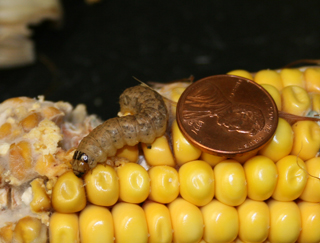
The corn-eating western bean cutworm appeared in Pennsylvania this year and other Great Lakes states in 2006.
By Allison Bush, bushalli@msu.edu
Great Lakes Echo
Aug. 12, 2009
Insects about an inch long are starting to eat their way through the Midwest’s corn and beans.
The western bean cutworm, native to the central high plains and western corn belt, was found in Pennsylvania for the first time this year. In 2006 it first appeared in Michigan, Ohio and Indiana.
“We thought it might be here, but we didn’t expect to find the distribution we already found – it’s surprising how widespread it already is,” said John Tooker, assistant professor of entomology at Pennsylvania State University.
In 2008, the cutworm was trapped in Wayne County, Ohio, about 90 miles from Pennsylvania. This summer, it has already appeared in nine Pennsylvania counties, including Lackawanna County, in the northeast portion of the state.
“They seem they can move a couple hundred miles easily in a year,” said Chris DiFonzo, a field crop entomologist at Michigan State University.
Western bean cutworms eat the ears of corn and munch on dry beans. They can have a devastating impact on farming, Tooker said.
“When they feed on field corn, it’s grain that would mostly go to animals, and because Pennsylvania is a dairy state, it’s quite concerning that it threatens the quality of the animal food supply.”
In the western U.S, where they are most abundant, the cutworms reduce yields by 30 to 40 percent.
New York has not pursued active trapping of the cutworm, but Tooker said his team found one of the moths, the adult form of the insect, only four miles from that state. That shows they are still traveling.
And the numbers are increasing in other Midwest states.
“Until this year, I would have classified it as an annoyance, but it looks as though this year it’s going to take on a pest status,” said John Obermeyer, integrated pest management specialist at Purdue University in Indiana.
Indiana is one of the top-producing popcorn states, and the cutworms could damage that industry, Obermeyer said.
“The larvae in the ears will take out 5 to 10 percent of the kernels, which is a bad thing in itself,” he said. “But there’s also going to be a concern about the quality.”
The popcorn industry is checking fields and spraying insecticides if necessary, he said.
And in Michigan, where the cutworms have already spread across the whole state, the main concern is extra expense for controlling them.
Cutworms can be killed by insecticides, but because they don’t typically appear until the end of July, when the corn has already grown to its full height, it can be difficult to apply the treatment.
“How do you spray tall corn?” DiFonzo said. “It’s a real problem in a lot of places, where they don’t have the equipment or aerial tools for that.”
There is a very narrow window when cutworms can be sprayed. In the early summer, they haven’t emerged from under the ground. In late summer, the larvae have already chewed through the husks to reach the kernels.
And this year farmers might be taken off guard. Due to the cooler temperatures, the cutworm moths are still seen flying in Michigan, DiFonzo said. They could still be laying eggs.
“A lot of growers won’t know they have a problem until they go to harvest in September or October, and then they’ll have a real surprise,” she said.